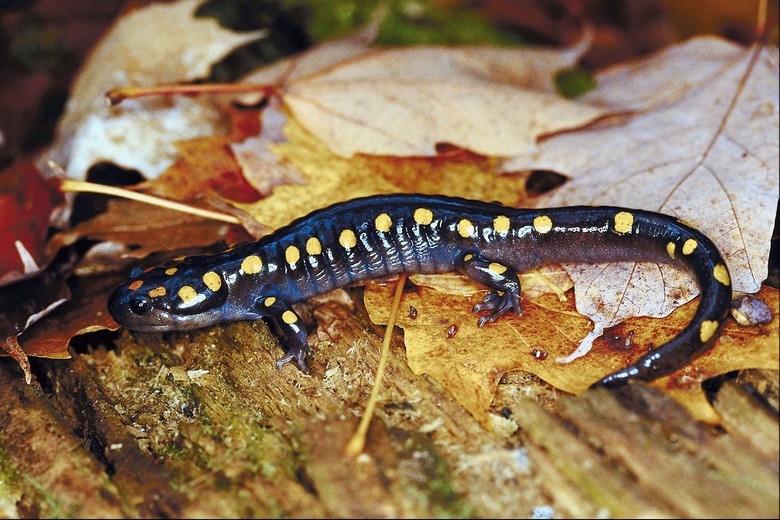Salamanders' Natural Habitat
Salamanders are carnivorous, long-lived amphibians with smooth, moist, close-fitting skin, four limbs and long, strong tails. The most primitive class of land-living vertebrates, amphibians were the first to emerge from an aquatic environment as larva and live on the land for much of their adult lives. Some salamander species have gills, while others have neither gills nor lungs and breathe through their skin or mouth. Most salamanders require standing water in which to breed and lay eggs, and all require a moist environment.
Mudpuppies
Mudpuppies
Mudpuppies, also known as waterdogs, are among the largest of the North American salamanders. Growing to 16 inches in length, they range from southern central Canada, through the midwestern United States, east to North Carolina and south to Georgia and Mississippi. Unlike other salamander species, mudpuppies retain external gills — found only in the larval stages of other salamanders — throughout their lives and are therefore restricted to living in permanent bodies of water, frequenting the bottom of riverside marshes, weedy ponds, lakes, rivers and streams; hiding in the weeds and vegetation or excavations under rocks and logs during the day and emerging at night to feed on crayfish, tadpoles, fish, worms, snails and aquatic insects.
Spotted Salamanders
Spotted Salamanders
Often referred to as "mole" salamanders because they usually live underground in tunnels throughout the summer, spotted salamanders are usually encountered around breeding ponds. Prevalent in mature deciduous forests from eastern Canada throughout the eastern and midwestern U.S., spotted salamanders hibernate in a network of underground tunnels found under stumps and logs, often preferring to use burrows made by moles or voles or enlarging tunnels left by old tree roots that have rotted away. They breed in temporary and permanent woodland pools and are known to share breeding pools with wood frogs. They stay hidden during the day and emerge only at night to feed or in spring to mate.
Tiger Salamanders
Tiger Salamanders
The most wide-ranging salamander species in North America, tiger salamanders are found throughout most of the U.S., southern Canada and eastern Mexico. One of the largest land-dwelling salamanders in the world, tiger salamanders live in deep burrows up to two feet below the earth's surface near ponds, lakes and slow-moving streams.
Eastern Red-Backed Salamanders
Eastern Red-Backed Salamanders
The only salamanders that are not dependent on standing water for larval development are Eastern red-backed salamanders. All respiration takes place through their skin since they have no lungs and they can only breathe when their skin is moist. Often the most abundant vertebrate in the landscape, their typical home range is less than 10 square feet and they live under logs and rocks or in moist rotting stumps in mature deciduous and mixed forests, cool, moist white pine and hemlock forests, wooded ravines and river valleys abundant with fallen logs, coarse woody debris and leaf litter. On hot, dry days, red-backed salamanders may hide underground and usually hibernate underground. They may also spend the winter in small mammal dens or ant mounds.
Other Lungless Salamanders
Other Lungless Salamanders
Lungless, four-toed salamanders are found in moss-fringed ponds in rich, damp woodlands, in the moss in bogs and under rocks and logs in mossy seepage areas. They hibernate in rotting logs, in tunnels under logs or under a deep layer of leaf litter.
Northern two-lined salamanders are small, slender lungless salamanders found beneath logs or under rocks along the edge of streams; they occasionally move into woodlands where they prefer to hide under logs in saturated seepage areas.
References
- "Familiar Amphibians & Reptiles of Ontario"; Bob Johnson
- "The Living World of Animals"; The Readers Digest Association
- National Geographic: Spotted Salamanders
- National Geographic: Tiger Salamanders
- Ontario Nature: Eastern Red-backed Salamanders
Cite This Article
MLA
Dorling, Susan. "Salamanders' Natural Habitat" sciencing.com, https://www.sciencing.com/salamanders-natural-habitat-1724/. 24 April 2017.
APA
Dorling, Susan. (2017, April 24). Salamanders' Natural Habitat. sciencing.com. Retrieved from https://www.sciencing.com/salamanders-natural-habitat-1724/
Chicago
Dorling, Susan. Salamanders' Natural Habitat last modified August 30, 2022. https://www.sciencing.com/salamanders-natural-habitat-1724/
